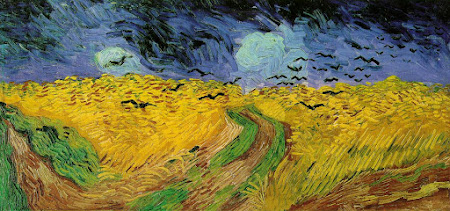As I stand before this painting, my heart races with a mix of awe and melancholy. Vincent Van Gogh's Wheatfield with Crows is a masterpiece that captures the essence of a summer day on a wheat field, yet it also depicts the artist's tormented soul. The painting is dominated by a vast expanse of yellow and gold, which represents the ripening wheat that covers the entire field. The sky is a deep blue, streaked with thin wisps of white clouds that seem to float aimlessly. The foreground is littered with dark patches of earth, and in the distance, a village can be seen. Yet, it's the crows that command attention. They are the only signs of life in the painting, soaring above the wheat in a frenzied dance, like harbingers of doom. Their ominous presence makes the wheat field seem abandoned, almost haunted.
1. "Wheatfield with Crows" author introduce
Vincent Van Gogh was a troubled genius who left a lasting mark on the art world. Born in the Netherlands in 1853, he was a self-taught artist who suffered from mental illness throughout his life. His struggles with depression, anxiety, and addiction are reflected in his paintings, which often feature intense colors and exaggerated forms. He produced more than 2,000 works of art in just over a decade, but his paintings were largely ignored during his lifetime. It was only after his death by suicide at the age of 37 that his work gained recognition. Today, he is considered one of the most influential artists of the 19th century, and his paintings sell for millions of dollars.
Among Van Gogh's most famous paintings is Wheatfield with Crows. Completed in July 1890, just weeks before his death, it's a hauntingly beautiful work that reflects his tortured state of mind. The painting is often interpreted as a symbol of Van Gogh's despair, and it's been suggested that the crows represent death and the end of hope. However, others see the painting as a celebration of life, with the wheat field symbolizing growth and renewal. Whatever interpretation one chooses, there's no denying that Wheatfield with Crows is a masterpiece that continues to captivate and intrigue viewers to this day.
2. "Wheatfield with Crows" introduce
In the heart of the Dutch countryside, there's a wheat field that's forever immortalized in a painting. Wheatfield with Crows is a work of art that captures the essence of the natural world, while also delving into the complexities of the human psyche. The painting is a masterful example of post-impressionism, with its bold colors and dynamic brushwork. It's a painting that demands attention, with its soaring crows and golden wheat field.
At first glance, Wheatfield with Crows seems like a simple painting, with its depiction of a summer day on a wheat field. However, as one looks closer, the painting reveals itself to be a complex meditation on life and death, hope and despair. It's a painting that reflects the turbulent mind of its creator, Vincent Van Gogh, who completed the work just weeks before his death by suicide. Yet, it's also a painting that transcends the artist's personal struggles, and speaks to the universal human experience of joy and suffering.
3. "Wheatfield with Crows" review
As I stand before Wheatfield with Crows, I'm struck by the sheer power and intensity of the painting. It's a work that captures the essence of nature, but also delves into the depths of the human soul. The crows, with their ominous presence, seem to signify the end of hope, while the wheat field represents the resilience of life. It's a painting that evokes a range of emotions, from awe to sadness to contemplation.
The brushstrokes are thick and heavy, as if Van Gogh was trying to convey a sense of urgency and intensity. The colors are vivid and bold, with the golden wheat field and deep blue sky contrasting sharply with the dark earth and black crows. It's a painting that draws you in and commands your attention, and it's impossible not to be moved by its beauty and complexity.
Yet, as much as Wheatfield with Crows is a celebration of life, it's also a reflection of death. The crows, with their sharp beaks and dark feathers, seem to loom over the wheat field, casting a shadow of gloom and despair. The painting is a testament to the fragility of life, and to the inevitability of death.
As I gaze at Wheatfield with Crows, I can't help but feel a sense of sadness and melancholy. It's a painting that speaks to the human condition, and to the struggle we all face to find meaning and purpose in life. Yet, it's also a painting that offers hope and redemption, reminding us that even in the darkest moments, there is still beauty and light to be found.
In the end, Wheatfield with Crows is a painting that defies easy interpretation. It's a work of art that speaks to each person differently, depending on their own experiences and worldview. Yet, for all its complexity and nuance, it remains a masterpiece that continues to inspire and captivate viewers to this day.

Comments
Post a Comment